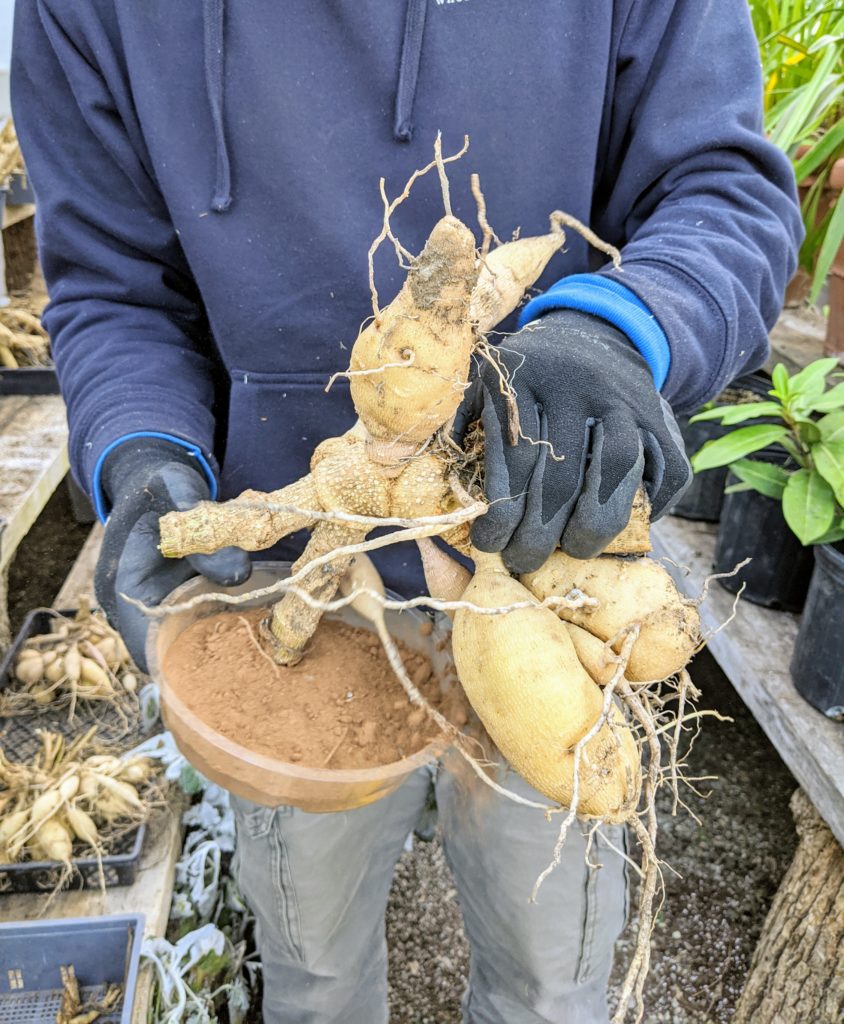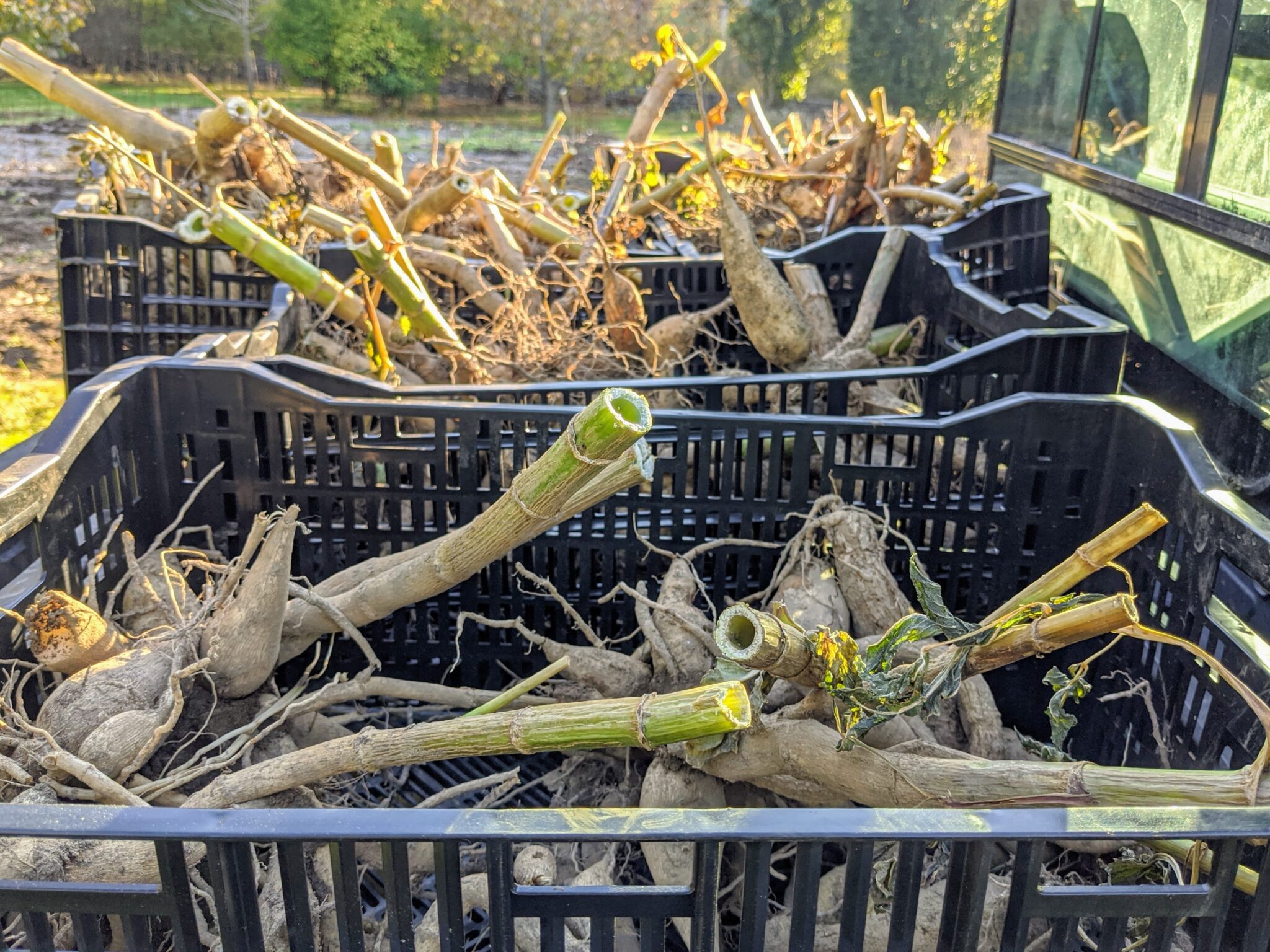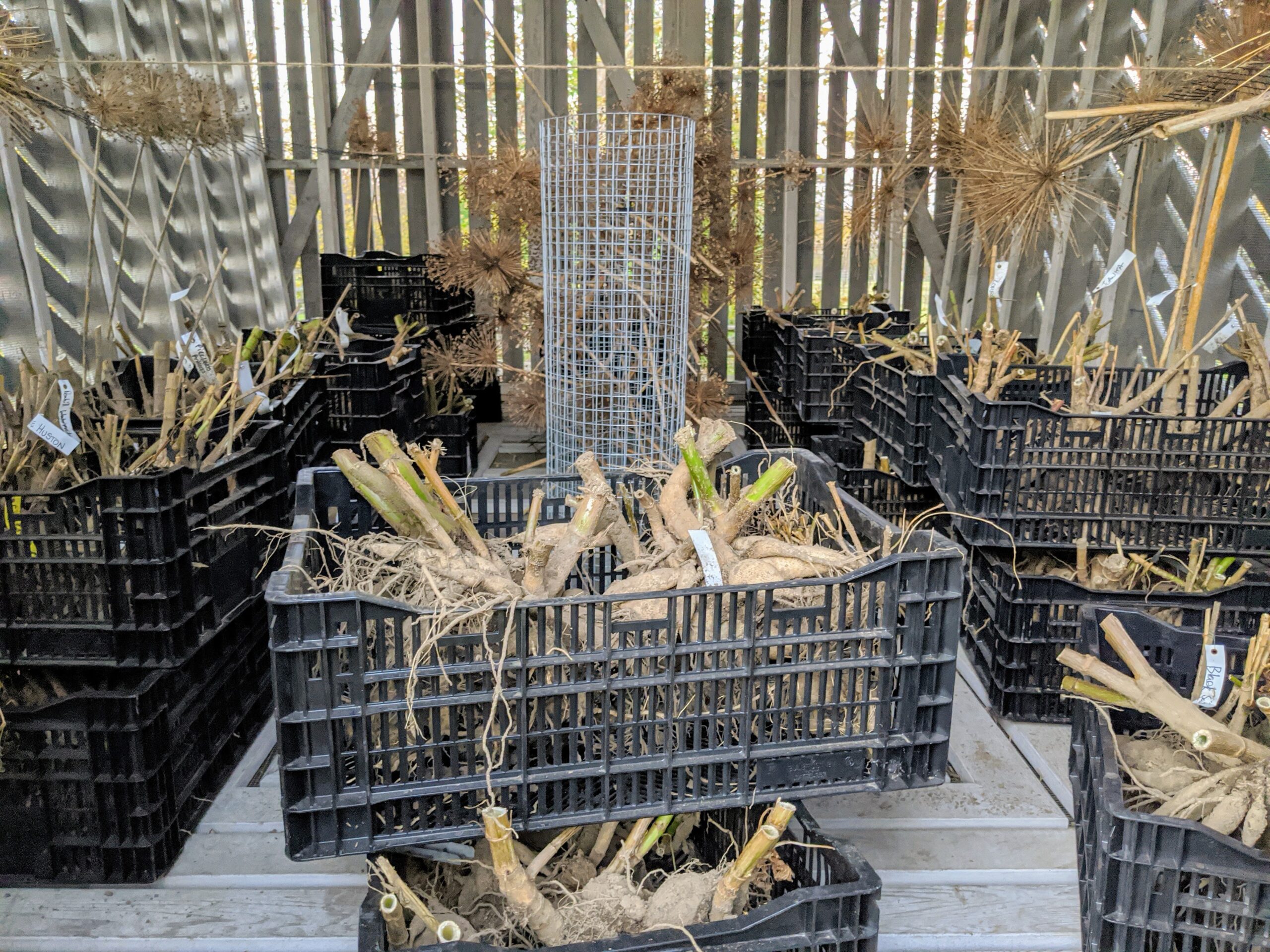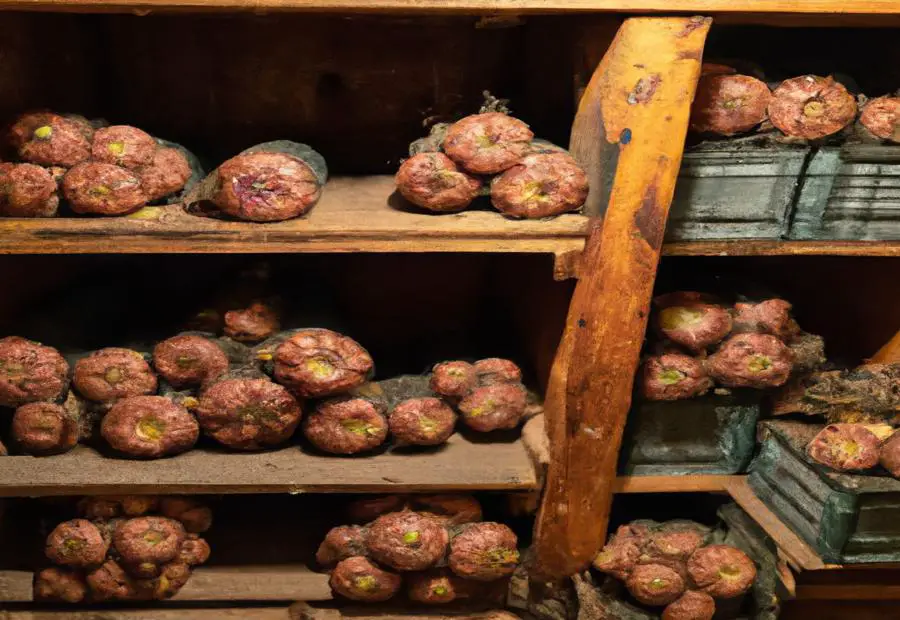Understanding the Importance of Proper Storage
Proper storage of tubers over winter is crucial for maintaining their quality, preventing spoilage, and ensuring a successful harvest the following year. Tubers, such as potatoes, sweet potatoes, and yams, are sensitive to temperature, humidity, and light, making it essential to store them in a controlled environment. When stored correctly, tubers can last for several months, providing a steady supply of nutritious food throughout the winter. However, improper storage can lead to rot, mold, and sprouting, rendering the tubers unusable.
One of the primary benefits of proper tuber storage is the preservation of nutrients. Tubers are rich in complex carbohydrates, fiber, and essential vitamins and minerals. When stored correctly, these nutrients are retained, ensuring that the tubers remain a healthy and nutritious food source. Additionally, proper storage helps to prevent the growth of pathogens and pests, reducing the risk of disease and contamination.
Furthermore, storing tubers over winter allows farmers and gardeners to extend the harvest season, providing a longer period of fresh produce. This can be particularly beneficial for small-scale farmers and home gardeners who rely on their harvest for food and income. By storing tubers correctly, they can enjoy a bountiful harvest throughout the winter months, reducing their reliance on external food sources.
When considering how to store tubers over winter, it is essential to understand the specific needs of each type of tuber. Different varieties have unique storage requirements, and failure to meet these needs can result in spoilage and reduced quality. For example, potatoes require a cool, dark environment with high humidity, while sweet potatoes prefer a warmer, drier space. By understanding these requirements, individuals can tailor their storage methods to meet the specific needs of their tubers.
In the following sections, we will explore the ideal storage conditions, preparation methods, and storage techniques for different types of tubers. By following these guidelines, individuals can ensure that their tubers remain fresh and nutritious throughout the winter months, providing a bountiful harvest for years to come.
Choosing the Right Storage Conditions
When it comes to storing tubers over winter, the right storage conditions are crucial for maintaining their quality and preventing spoilage. The ideal storage environment for tubers is one that is cool, dark, and humid. The temperature should be between 32°F and 40°F (0°C and 4°C), with a relative humidity of 80-90%. This will help to slow down the tubers’ metabolic processes, preventing them from sprouting or rotting.
One of the most effective ways to create a suitable storage environment is to use a root cellar. A root cellar is a specialized storage room that is designed to maintain a consistent temperature and humidity level. It is typically built underground, which helps to regulate the temperature and keep the tubers cool. If you don’t have a root cellar, you can also use a cool, dark basement or a storage room with a consistent temperature.
In addition to temperature and humidity, light is also an important factor to consider when storing tubers. Tubers should be stored in complete darkness, as light can cause them to sprout or become green. This is why it’s essential to use a storage room or container that is opaque and blocks out any light.
Another important consideration is ventilation. While it’s essential to maintain a humid environment, it’s also important to ensure that there is adequate ventilation to prevent the buildup of ethylene gas. Ethylene gas is a natural byproduct of tuber respiration, and it can cause the tubers to ripen or spoil more quickly. By providing adequate ventilation, you can help to remove excess ethylene gas and maintain a healthy storage environment.
When storing tubers, it’s also essential to consider the specific needs of each type of tuber. For example, potatoes require a slightly warmer temperature than sweet potatoes, while yams prefer a more humid environment. By understanding the specific needs of each type of tuber, you can tailor your storage conditions to meet their requirements and ensure that they remain fresh and healthy throughout the winter months.
By following these guidelines and creating a suitable storage environment, you can help to ensure that your tubers remain fresh and healthy throughout the winter months. In the next section, we will explore the steps to prepare tubers for storage, including cleaning, drying, and curing.
Preparing Tubers for Storage
Before storing tubers over winter, it’s essential to prepare them properly to ensure they remain fresh and healthy. The preparation process involves cleaning, drying, and curing the tubers. This helps to remove any dirt, debris, or excess moisture that can cause spoilage or rot.
Cleaning the tubers is the first step in the preparation process. Use a soft-bristled brush or a clean cloth to gently remove any dirt or debris from the surface of the tubers. Avoid using water or any cleaning solutions, as this can damage the tubers or cause them to rot.
After cleaning, the tubers need to be dried to remove any excess moisture. This can be done by spreading them out in a single layer on a clean surface, such as a paper bag or a breathable cloth. Allow the tubers to air dry for several hours or overnight, depending on the humidity and temperature.
Curing is the final step in the preparation process. This involves allowing the tubers to heal any wounds or cuts that may have occurred during harvesting. To cure the tubers, place them in a warm, dry location with good ventilation. The ideal temperature for curing is between 60°F and 70°F (15°C and 21°C), with a relative humidity of 80-90%. Allow the tubers to cure for 2-4 weeks, or until the wounds have healed and the skin has hardened.
It’s essential to handle different types of tubers differently during the preparation process. For example, potatoes require a slightly longer curing period than sweet potatoes, while yams need to be handled more gently to avoid bruising. By understanding the specific needs of each type of tuber, you can tailor your preparation process to meet their requirements and ensure they remain fresh and healthy throughout the winter months.
When preparing tubers for storage, it’s also important to inspect them for any signs of damage or disease. Remove any tubers that are damaged or diseased, as these can spoil quickly and affect the rest of the stored tubers. By carefully preparing and inspecting your tubers, you can help ensure a successful storage experience and enjoy a bountiful harvest the following year.
Storage Methods for Different Types of Tubers
When it comes to storing tubers over winter, different types of tubers require different storage methods. Understanding the specific needs of each type of tuber is crucial for maintaining their quality and preventing spoilage. In this section, we will explore various storage methods for different types of tubers, including hilling, mounding, and container storage.
Hilling is a popular storage method for potatoes and sweet potatoes. This involves creating a mound of soil or straw around the tubers, which helps to regulate the temperature and humidity. The mound should be about 2-3 feet high and 4-6 feet wide, with the tubers placed in the center. This method is ideal for small-scale farmers and gardeners who want to store a few dozen tubers.
Mounding is another storage method that is similar to hilling. However, instead of creating a mound of soil or straw, a layer of mulch or straw is placed on top of the tubers. This helps to retain moisture and regulate the temperature. Mounding is a good option for storing yams and other types of tubers that require a slightly warmer temperature.
Container storage is a great option for storing tubers in a small space. This involves placing the tubers in a container, such as a plastic bin or a wooden crate, and covering them with a layer of mulch or straw. The container should be kept in a cool, dark place, such as a basement or a root cellar. This method is ideal for storing a few dozen tubers and is a good option for urban gardeners.
When storing tubers, it’s essential to consider the specific needs of each type of tuber. For example, potatoes require a slightly cooler temperature than sweet potatoes, while yams need to be stored in a warmer environment. By understanding the specific needs of each type of tuber, you can choose the best storage method and ensure that they remain fresh and healthy throughout the winter months.
In addition to the storage methods mentioned above, there are also other options available, such as using a root cellar or a cold frame. A root cellar is a specialized storage room that is designed to maintain a consistent temperature and humidity level. A cold frame is a structure that is designed to protect plants from frost and cold temperatures. Both of these options are ideal for storing tubers and can provide a consistent supply of fresh produce throughout the winter months.
Monitoring and Maintaining Stored Tubers
Regular monitoring and maintenance are crucial for ensuring the quality and longevity of stored tubers. By checking on the tubers regularly, you can identify any potential issues before they become major problems. In this section, we will discuss the importance of monitoring and maintaining stored tubers, including checking for moisture, temperature, and pest control.
Moisture is one of the most critical factors to monitor when storing tubers. If the storage environment is too humid, the tubers may rot or develop mold. On the other hand, if the environment is too dry, the tubers may shrivel up and lose their flavor. To check for moisture, you can use a hygrometer to measure the relative humidity of the storage environment. Ideally, the relative humidity should be between 80-90%.
Temperature is another important factor to monitor when storing tubers. If the storage environment is too warm, the tubers may sprout or develop off-flavors. On the other hand, if the environment is too cold, the tubers may become dormant and lose their flavor. To check for temperature, you can use a thermometer to measure the temperature of the storage environment. Ideally, the temperature should be between 32°F and 40°F (0°C and 4°C).
Pest control is also an important aspect of monitoring and maintaining stored tubers. Pests such as rodents, insects, and mold can damage the tubers and reduce their quality. To control pests, you can use traps, repellents, or other methods to keep them away from the stored tubers.
In addition to monitoring for moisture, temperature, and pest control, it’s also important to check on the tubers regularly for signs of spoilage or disease. This can include checking for soft spots, mold, or other visible signs of damage. By catching any issues early, you can prevent them from spreading and reduce the risk of losing your entire harvest.
By regularly monitoring and maintaining your stored tubers, you can ensure that they remain fresh and healthy throughout the winter months. This will not only help you to enjoy a bountiful harvest, but also provide you with a sense of satisfaction and accomplishment.
Common Mistakes to Avoid When Storing Tubers
When storing tubers over winter, there are several common mistakes to avoid in order to ensure successful storage. In this section, we will discuss some of the most common mistakes and provide guidance on how to avoid them.
Inadequate ventilation is one of the most common mistakes when storing tubers. If the storage environment is not well-ventilated, the tubers may become too humid, leading to rot and spoilage. To avoid this mistake, make sure to provide adequate ventilation in the storage environment, such as using a fan or opening a window.
Incorrect temperature is another common mistake when storing tubers. If the storage environment is too warm or too cold, the tubers may not store properly. To avoid this mistake, make sure to store the tubers in a cool, dark place with a consistent temperature between 32°F and 40°F (0°C and 4°C).
Poor handling is also a common mistake when storing tubers. If the tubers are handled roughly or dropped, they may become bruised or damaged, leading to spoilage. To avoid this mistake, make sure to handle the tubers gently and carefully, and avoid dropping them or subjecting them to excessive vibration.
Not monitoring the storage environment is another common mistake when storing tubers. If the storage environment is not monitored regularly, the tubers may become too humid or develop pests, leading to spoilage. To avoid this mistake, make sure to monitor the storage environment regularly, checking for signs of spoilage or pests.
Not preparing the tubers properly before storage is also a common mistake. If the tubers are not cleaned, dried, and cured properly before storage, they may not store well. To avoid this mistake, make sure to prepare the tubers properly before storage, following the steps outlined in the previous section.
By avoiding these common mistakes, you can ensure successful storage of your tubers and enjoy a bountiful harvest the following year.
Using Technology to Enhance Tuber Storage
Technology can play a significant role in enhancing tuber storage, particularly when it comes to maintaining optimal temperature and humidity levels. In this section, we will explore the use of technology, such as temperature control systems and humidity monitors, to enhance tuber storage.
Temperature control systems are designed to maintain a consistent temperature within a storage environment. These systems can be programmed to maintain a specific temperature range, ensuring that the tubers are stored at the optimal temperature for their type. For example, potatoes require a temperature range of 32°F to 40°F (0°C to 4°C), while sweet potatoes require a temperature range of 55°F to 65°F (13°C to 18°C).
Humidity monitors are another type of technology that can be used to enhance tuber storage. These monitors measure the relative humidity within the storage environment, ensuring that it remains within the optimal range for the type of tuber being stored. For example, potatoes require a relative humidity of 80% to 90%, while sweet potatoes require a relative humidity of 60% to 70%.
In addition to temperature control systems and humidity monitors, other technologies can also be used to enhance tuber storage. For example, automated ventilation systems can be used to maintain optimal air circulation within the storage environment, while sensors can be used to detect any changes in temperature or humidity.
The benefits of using technology to enhance tuber storage are numerous. For example, it can help to maintain optimal storage conditions, reduce the risk of spoilage, and increase the overall quality of the tubers. Additionally, technology can help to automate many of the tasks associated with tuber storage, making it easier and more efficient to manage the storage environment.
However, there are also some limitations to using technology to enhance tuber storage. For example, the initial cost of purchasing and installing the technology can be high, and there may be ongoing maintenance and repair costs. Additionally, the technology may require a power source, which can be a concern in areas where power outages are common.
Despite these limitations, the use of technology to enhance tuber storage can be a valuable investment for farmers and gardeners. By maintaining optimal storage conditions and reducing the risk of spoilage, technology can help to ensure a successful harvest and increase the overall quality of the tubers.
Conclusion: Successful Tuber Storage for a Bountiful Harvest
Proper tuber storage is crucial for maintaining the quality and freshness of your harvest over winter. By following the guidelines outlined in this article, you can ensure that your tubers remain healthy and flavorful throughout the winter months. Remember to choose the right storage conditions, prepare your tubers for storage, and monitor and maintain them regularly.
Additionally, consider using technology to enhance your tuber storage, such as temperature control systems and humidity monitors. These tools can help you maintain optimal storage conditions and reduce the risk of spoilage.
By implementing these methods and techniques, you can enjoy a bountiful harvest the following year. Don’t let your hard work go to waste – take the time to properly store your tubers and reap the rewards of a successful harvest.
Whether you’re a seasoned farmer or a beginner gardener, proper tuber storage is essential for maintaining the quality and freshness of your harvest. By following the guidelines outlined in this article, you can ensure that your tubers remain healthy and flavorful throughout the winter months.
So, don’t wait any longer – start preparing your tubers for storage today With the right techniques and tools, you can enjoy a successful harvest and a bountiful supply of fresh, delicious tubers all year round.








:max_bytes(150000):strip_icc()/dahlia-tubers-in-Ziploc-56a583c83df78cf77288adb6.jpg)